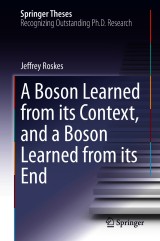Details

A Boson Learned from its Context, and a Boson Learned from its End
Springer Theses
|
96,29 € |
|
| Verlag: | Springer |
| Format: | |
| Veröffentl.: | 19.11.2020 |
| ISBN/EAN: | 9783030580117 |
| Sprache: | englisch |
Dieses eBook enthält ein Wasserzeichen.
Beschreibungen
This thesis develops fundamental ideas and advanced techniques for studying the Higgs boson’s interactions with the known matter and force particles. The Higgs boson appears as an excitation of the Higgs field, which permeates the vacuum. Several other phenomena in our Universe, such as dark energy, dark matter, and the abundance of matter over antimatter, remain unexplained. The Higgs field may prove to be the connection between our known world and the “dark” world, and studies of the Higgs boson's interactions are essential to reveal possible new phenomena. The unique feature of this work is simultaneous measurement of the Higgs boson’s associated production (its context, to use the language of the title) and its decay (its end), while allowing for multiple parameters sensitive to new phenomena. This includes computer simulation with Monte Carlo techniques of the complicated structure of the Higgs boson interactions, the matrix-element calculation of per-event likelihoods for optimal observables, and advanced fitting methods with hundreds of intricate components that cover all possible parameters and quantum mechanical interference. This culminates in the most advanced analysis of LHC data in the multi-parameter approach to Higgs physics in its single golden four-lepton decay channel to date. Optimization of the CMS detector’s silicon-based tracking system, essential for these measurements, is also described.
<p></p><p>Chapter 1: Introduction.- Chapter 2: The Experiment.- Chapter 3: Alignment and calibration of the CMS tracker.- Chapter 4: Phenomenology of Higgs boson interactions.- Chapter 5: Higgs boson data analysis.- Chapter 6: Conclusions and future directions.</p><p></p>
<p>Jeffrey "Heshy" Roskes was born in July, 1993 in Baltimore, Maryland, where he has lived his entire life.<br> He attended Johns Hopkins University, also in Baltimore, receiving a B.S. in 2014 in Physics with University and<br> Departmental Honors and a second major in Mathematics. During his undergraduate career, he received the Donald E. Kerr Memorial Award in Physics, and he earned membership in Phi Beta Kappa and Sigma Pi Sigma.<br> As an undergraduate, Heshy began working as a research assistant on the CMS experiment, focusing on alignment of the CMS tracker. He was awarded a Dean’s Undergraduate Research Award to travel to CERN and work on the project there.<br> <br> Heshy enrolled in the physics Ph.D. program at Hopkins, continuing his work in the CMS project.<br> He was awarded the Donald E. Kerr Sr. and Barbara Kerr Stanley Fellowship as well as the William Gardner Fellowship. He continued his work in tracker alignment, eventually serving as convener of the CMS tracker alignment group, and developed many analyses to study and characterize the Higgs boson. Heshy authored numerous papers as a member of the CMS Collaboration and was a main author of a series of papers analyzing properties of the Higgs boson. He is an author of the JHUGen and MELA package, and in that role co-authored a Higgs Cross Section Working Group report and an independent paper. He taught several basic and advanced physics courses as a graduate student. Heshy is currently working in data science as applied to medical imaging at the Institute for Data Intensive Engineering and Science, also at Hopkins.</p>
This thesis develops fundamental ideas and advanced techniques for studying the Higgs boson’s interactions with the known matter and force particles. The Higgs boson appears as an excitation of the Higgs field, which permeates the vacuum. Several other phenomena in our Universe, such as dark energy, dark matter, and the abundance of matter over antimatter, remain unexplained. The Higgs field may prove to be the connection between our known world and the “dark” world, and studies of the Higgs boson's interactions are essential to reveal possible new phenomena. The unique feature of this work is simultaneous measurement of the Higgs boson’s associated production (its context, to use the language of the title) and its decay (its end), while allowing for multiple parameters sensitive to new phenomena. This includes computer simulation with Monte Carlo techniques of the complicated structure of the Higgs boson interactions, the matrix-element calculation of per-event likelihoods for optimal observables, and advanced fitting methods with hundreds of intricate components that cover all possible parameters and quantum mechanical interference. This culminates in the most advanced analysis of LHC data in the multi-parameter approach to Higgs physics in its single golden four-lepton decay channel to date. Optimization of the CMS detector’s silicon-based tracking system, essential for these measurements, is also described.
Nominated as an outstanding PhD thesis by Johns Hopkins University Provides an overview of the history and context of the Standard Model and experimental searches for the Higgs boson at LHC Describes significant advances in understanding the Higgs boson’s production and decay
Diese Produkte könnten Sie auch interessieren:

Introduction to Focused Ion Beams

von: Lucille A. Giannuzzi, Lucille A. North Carolina State University

128,39 €















